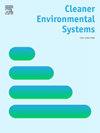{"title":"Implementing strong sustainability in a design process","authors":"Melissa Escobar Cisternas , Jenny Faucheu , Nadege Troussier , Valerie Laforest","doi":"10.1016/j.cesys.2024.100224","DOIUrl":null,"url":null,"abstract":"<div><p>The emergence of a post-growth era is expected that implies rethinking the production and consumption patterns with novel design models this forces higher educational institutions to reconsider their traditional ways of teaching sustainability in their curricula. Companies also need to overcome strategies that compartmentalize environment, society and economy in their industrial strategy in order to evolve in their support for the transition. The aim of this paper is to present a design process anchored in the Strong Sustainability paradigm to overcome the gap of how Strong Sustainability could be operationalised. Design Research Methodology (DRM) has been chosen as the supporting framework for the development of this project. The Design for Strong Sustainability (DfSoSy) methodology proposed, is built on three aspects of Strong Sustainability (Milieu, Regeneration, Safe and just operating space) successively applied in a sequenced iterative design process. The latter enable the integration of thought patterns associated with integrative, systemic and fractal or multi-scale thinking respectively. Moreover, the principle of sub-optimality is highlighted as a decision principle in SoSy. Results obtain has been validated as well on the pedagogical objectives as in the usefulness of the DfSoSy. The practical contribution of this study is the DfSoSy toolkit©.</p></div>","PeriodicalId":34616,"journal":{"name":"Cleaner Environmental Systems","volume":"15 ","pages":"Article 100224"},"PeriodicalIF":6.1000,"publicationDate":"2024-09-12","publicationTypes":"Journal Article","fieldsOfStudy":null,"isOpenAccess":false,"openAccessPdf":"https://www.sciencedirect.com/science/article/pii/S266678942400062X/pdfft?md5=07fa30ed2ac22fb2d27336fe3f7353b6&pid=1-s2.0-S266678942400062X-main.pdf","citationCount":"0","resultStr":null,"platform":"Semanticscholar","paperid":null,"PeriodicalName":"Cleaner Environmental Systems","FirstCategoryId":"1085","ListUrlMain":"https://www.sciencedirect.com/science/article/pii/S266678942400062X","RegionNum":0,"RegionCategory":null,"ArticlePicture":[],"TitleCN":null,"AbstractTextCN":null,"PMCID":null,"EPubDate":"","PubModel":"","JCR":"Q2","JCRName":"ENGINEERING, ENVIRONMENTAL","Score":null,"Total":0}
引用次数: 0
在设计过程中实施强有力的可持续性
预计后增长时代的出现意味着要以新颖的设计模式重新思考生产和消费模式,这就迫使高等院校重新考虑在课程中教授可持续发展知识的传统方式。企业也需要克服在其产业战略中将环境、社会和经济割裂开来的战略,以便在支持转型中不断发展。本文旨在介绍一个以强可持续性范式为基础的设计过程,以克服如何将强可持续性付诸实施的差距。设计研究方法论(DRM)被选为该项目的支持框架。所提出的 "强可持续性设计"(DfSoSy)方法建立在 "强可持续性 "的三个方面(环境、再生、安全和公正的操作空间)之上,并在一个有序的迭代设计过程中连续应用。后者能够整合与综合、系统和分形或多尺度思维相关的思维模式。此外,次优化原则作为 SoSy 的决策原则得到了强调。研究结果既验证了教学目标,也验证了 DfSoSy 的实用性。本研究的实际贡献在于 DfSoSy 工具包©。
本文章由计算机程序翻译,如有差异,请以英文原文为准。


